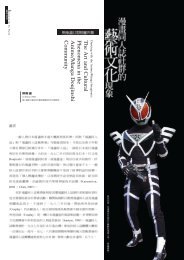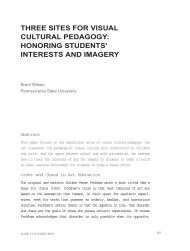Being-there: an Existentialism Point of View in Egon Schiele's Self ...
Being-there: an Existentialism Point of View in Egon Schiele's Self ...
Being-there: an Existentialism Point of View in Egon Schiele's Self ...
You also want an ePaper? Increase the reach of your titles
YUMPU automatically turns print PDFs into web optimized ePapers that Google loves.
國際藝術教育學刊<br />
<strong>Be<strong>in</strong>g</strong>-<strong>there</strong>: <strong>an</strong><br />
<strong>Existentialism</strong> <strong>Po<strong>in</strong>t</strong> <strong>of</strong><br />
<strong>View</strong> <strong>in</strong> <strong>Egon</strong> <strong>Schiele's</strong><br />
<strong>Self</strong>-portraits<br />
154<br />
Look at Schiele’s works, he created “The self-seers <strong>an</strong>d the<br />
Prophet” <strong>in</strong> 1911, through which we c<strong>an</strong> see the method <strong>of</strong> double<br />
me<strong>an</strong><strong>in</strong>g. Fr<strong>an</strong>k Whitford (1981:109)once said:<br />
The self-seers, <strong>of</strong> which <strong>there</strong> are three versions, is a double self-portrait<br />
<strong>an</strong>d ,as such, relates to the theme <strong>of</strong> the Dopplgänger, so popular <strong>in</strong><br />
Germ<strong>an</strong> Rom<strong>an</strong>tic literature…These pa<strong>in</strong>t<strong>in</strong>gs clearly allude to such<br />
symbolic confrontations with the self, as they do to those self-portraits,<br />
also common <strong>in</strong> the n<strong>in</strong>eteenth century<br />
Schiele was quite affected by current literature <strong>an</strong>d existentialism.<br />
His self-portrait expressed a certa<strong>in</strong> double self to show the separation<br />
between ego <strong>an</strong>d spirit. In 1915, he pa<strong>in</strong>ted <strong>an</strong>other famous works<br />
named double self-portrait. In this pa<strong>in</strong>t<strong>in</strong>g, two egos gazed at the<br />
same place; we c<strong>an</strong> see the shift from conflict to harmony <strong>in</strong> the<br />
author’s heart.<br />
[ill. 4]<br />
The self-seers, 1911 Oil on<br />
c<strong>an</strong>vas 80.5×80cm Private<br />
collection<br />
[ill.5]<br />
The prophet, 1911<br />
Oil on c<strong>an</strong>vas 110.3<br />
×50.3㎝ Private<br />
collection<br />
3.3. be<strong>in</strong>g <strong>an</strong>d Mitse<strong>in</strong>-portrait with others<br />
[ill.6]<br />
Double self-portrait, 1915 Gouache, watercolour<br />
<strong>an</strong>d pencil42.5×49.4cm Private collection<br />
We c<strong>an</strong> see from his portrait with other people <strong>an</strong>d f<strong>in</strong>d how<br />
Schiele felt about his relationship with others. <strong>Existentialism</strong> believed<br />
that as long as m<strong>an</strong> lived <strong>in</strong> the world he had to be related with<br />
other people. But m<strong>an</strong> will gradually lose his <strong>in</strong>dependent thought<br />
InJAE 5.1 © NTAEC 2007





